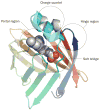Metabolic functions of FABPs--mechanisms and therapeutic implications
- PMID: 26260145
- PMCID: PMC4578711
- DOI: 10.1038/nrendo.2015.122
Metabolic functions of FABPs--mechanisms and therapeutic implications
Abstract
Intracellular and extracellular interactions with proteins enables the functional and mechanistic diversity of lipids. Fatty acid-binding proteins (FABPs) were originally described as intracellular proteins that can affect lipid fluxes, metabolism and signalling within cells. As the functions of this protein family have been further elucidated, it has become evident that they are critical mediators of metabolism and inflammatory processes, both locally and systemically, and therefore are potential therapeutic targets for immunometabolic diseases. In particular, genetic deficiency and small molecule-mediated inhibition of FABP4 (also known as aP2) and FABP5 can potently improve glucose homeostasis and reduce atherosclerosis in mouse models. Further research has shown that in addition to their intracellular roles, some FABPs are found outside the cells, and FABP4 undergoes regulated, vesicular secretion. The circulating form of FABP4 has crucial hormonal functions in systemic metabolism. In this Review we discuss the roles and regulation of both intracellular and extracellular FABP actions, highlighting new insights that might direct drug discovery efforts and opportunities for management of chronic metabolic diseases.
Conflict of interest statement
G.S.H. receives research funding under a sponsored agreement with Union Chimique Belge. D.A.B. declares no competing interests.
Figures





References
-
- Poveda JA, et al. Lipid modulation of ion channels through specific binding sites. Biochim Biophys Acta. 2014;1838:1560–1567. - PubMed
-
- Wahli W, Michalik L. PPARs at the crossroads of lipid signaling and inflammation. Trends Endocrinol Metab. 2012;23:351–363. - PubMed
-
- Shimizu T. Lipid mediators in health and disease: enzymes and receptors as therapeutic targets for the regulation of immunity and inflammation. Annu Rev Pharmacol Toxicol. 2009;49:123–150. - PubMed
-
- Cho H, et al. Insulin resistance and a diabetes mellitus-like syndrome in mice lacking the protein kinase Akt2 (PKB β) Science. 2001;292:1728–1731. - PubMed
Publication types
MeSH terms
Substances
Grants and funding
LinkOut - more resources
Full Text Sources
Other Literature Sources
Molecular Biology Databases
Research Materials
Miscellaneous

